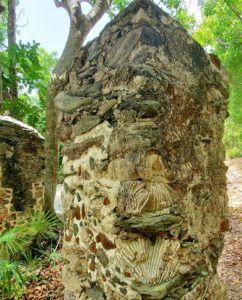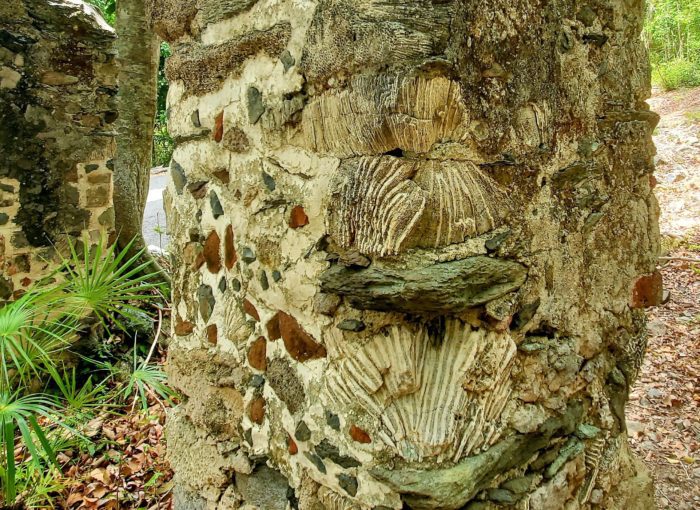One of my favorite architectural details on St. John is the incorporation of rock, seashells, and coral into many of the walls and buildings. I always assumed it was purely for aesthetics. Well, you know what they say about assuming.
In my quest to learn more about St. John, I researched the building techniques used by the West Indians in the 16th and 17th centuries. The West Indian method of construction was largely influenced by European craftsmanship and traditional methods from Africa. The materials most often used included brick, natural stone, lime, ash, hardwood, pitch pine, iron, linseed oil, red lead, and pigments.
My favorite: Natural stone.
The coastal reef surrounding St. John is composed of limestone formed from coral. Appropriately (and obviously) named, this material is called ‘coral stone’. The coral stone is quite soft, which makes it an ideal source for cutting into large blocks for stacking. Contrary to what one would think given the soft structure, coral stone actually withstands the weather better and for a longer duration than brick. Another interesting benefit of the porous nature of the stone – and a beneficial one given the warm tropical environment – is that it absorbs the moisture in the wall, which slowly evaporates and creates a cooling effect on sunny days!
Lime was a mandatory ingredient in construction in the early years, and can be found in the form of conch and mussel shells, coral, and coral stone. Raw lime was burned at high temperatures in a kiln, placed in a hole in the ground, and mixed with water. Eventually, the material breaks down and forms a light, soft substance that resembles bread dough. Mixing it with sand and water creates a mortar which was used as plaster. With further dilution, this substance becomes a whitewash, which acts as a natural disinfectant. As such, it was common for residents in the VI to whitewash their buildings with this material at the end of every hurricane season.
So … Where Am I?
Hint: This half mile trail provides a glimpse into St. John’s primary industry in the 1700s.




Cinnamon Bay Trail.
Brown bay back in the trees
Anna burg Ruins
Cinnamon Bay trail
Anna burg Ruins
Annaburg ruins
Brown Bay ruins
Cinnamon ruins
You got it!
Love love the article BTW :0)
Thank you Tracy!
Interesting info about the building material used.
I’m going to guess Annaberg.
Glad you enjoyed it, Debbie! It’s not Annaberg, but that’s a really good guess. It’s the beginning of the trail at Cinnamon!
Cinnamon ruins
Correct!
This is such an informative article. I love hearing the historical and practical significance of why things are the way they are. Well done!
Thank you Kathy! We greatly appreciate the feedback, and will be doing more of this in future posts!